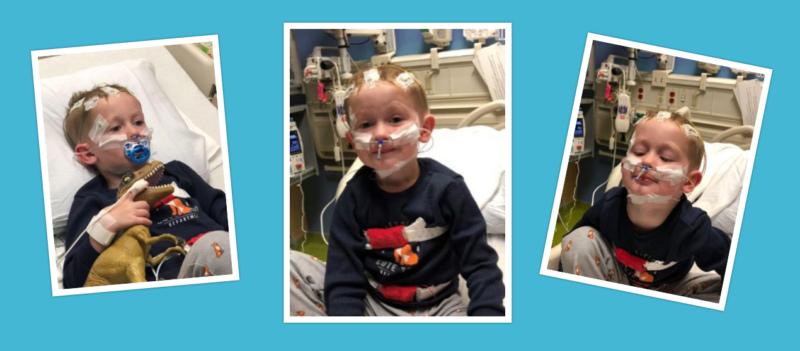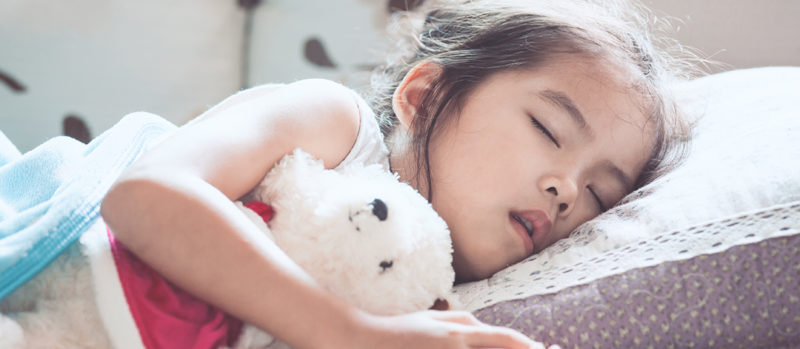A sleep study is kind of a funny thing. It takes place overnight at the hospital, but isn’t really a hospitalization. Our family has now experienced two sleep studies – my wife experienced one with our daughter, Cecilia, when she was 3. And I recently went through one with our son, Colin.
At age 2, Colin was often restless at night and had a hard time staying asleep. That led to him being lethargic during the day. His tonsils were enlarged, so his ENT doctor (otolaryngologist) prescribed a sleep study to help determine if that or anything else was contributing to his poor sleep.
Here’s what Colin and I experienced with Colin’s sleep study, to give you an idea of what to expect, along with some tips to make your night in the hospital as smooth as possible.
Preparing for a Sleep Study
We received a letter from the Sleep Center ahead of time with instructions, so I had some good information to share with Colin about what would take place. We also showed Colin photos of his sister when she had her sleep study to help prepare him. I’d suggest explaining the study to your child in advance so there are as few surprises as possible. But also know your child — if talking about it too much will cause your child to worry, just give a brief explanation.
Pack an overnight bag with whatever you need from home for a comfortable night’s sleep. We took the same things we’d pack for an overnight with the grandparents.
Arrival at the Hospital
Colin and I arrived at the hospital at about 7 p.m. Colin could show up in his pajamas or change there. It was fun for him to put on his pajamas early and ride in the car in comfy jammies, so that’s what we did.
As soon as we walked in, the Sleep Lab team got to work. They prepared the equipment for the study, including sensors, belts, tubes and wires that were placed on Colin’s body using removable adhesives like tape and glue. These monitor things like brain activity, breathing and muscle activity. Colin had more than 20 different things put on all parts of his body — head, neck, chest, chin, hand, and more.
Our respiratory therapist/sleep technologists (which I’ll call “techs” from here on out) showed us the equipment and let Colin touch it all. They played games with him as they were attaching everything, which Colin enjoyed.
It took about 30 minutes to get everything hooked up. Our techs said sometimes it takes up to an hour depending on the child. Fortunately, they did a great job keeping Colin engaged in the process the whole time. They talked with him and worked as fast as they could. I had been a bit nervous about how Colin would do with this. But the way the techs handled it — quickly, efficiently, and in a fun way for Colin — made it a lot less stressful than I thought it would be.
Going to Bed
When they were finished, the techs tied up the wires and put them behind Colin in a kind of ponytail of wires. Then they put a small set of tubes called a nasal cannula just inside his nose to monitor his breathing. They again showed him this beforehand and let him touch it.
By this time, it was close to Colin’s bedtime. We went through his usual routine of brushing teeth and reading a book, and then it was time for bed.
I sat at the side of the bed until Colin fell asleep. He was able to use his pacifier, which was great. The room was a typical hospital room with a bed, TV, pullout chair and private bathroom. Room-darkening shades were over the windows and door to make a good sleeping environment. It took Colin about 20 minutes to settle down and fall asleep, and then I was able to go to sleep on the pullout chair next to Colin’s bed.
A tech came in periodically throughout the night to readjust the monitors from Colin moving around. If he moved and something came loose, they needed to fix it so they could still get good results from the study. They did that quietly, and I didn’t find it much of a disruption for either of us. Colin woke up once in the night and went back to sleep, which was a pretty standard night of sleep for him.
Waking Up and Next Steps
Families are awoken in the morning between 6-7 a.m. The techs came in and started detaching the equipment right away. They used a special adhesive remover that made taking off the sensors quick and easy. Then we were able to leave. All of our paperwork was ready, so that process was quick.
The sleep study results were sent to the doctor who ordered the test. We learned about the results of Colin’s study in a follow-up appointment not long after the study was done.
I found the whole sleep study experience relatively painless. The Sleep Lab team was very accommodating. I was especially pleased with how quickly they worked and how they made Colin feel so at ease. They were a calming influence in the room. And I got a decent night’s sleep too.
I hope your sleep study goes as well as ours did, and that you find the results you need to help your child be as healthy as possible.
To schedule an appointment with the Sleep Center at Cincinnati Children’s, call, 513-636-1077, or email sleep@cchmc.org.


